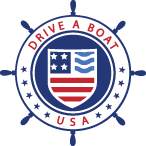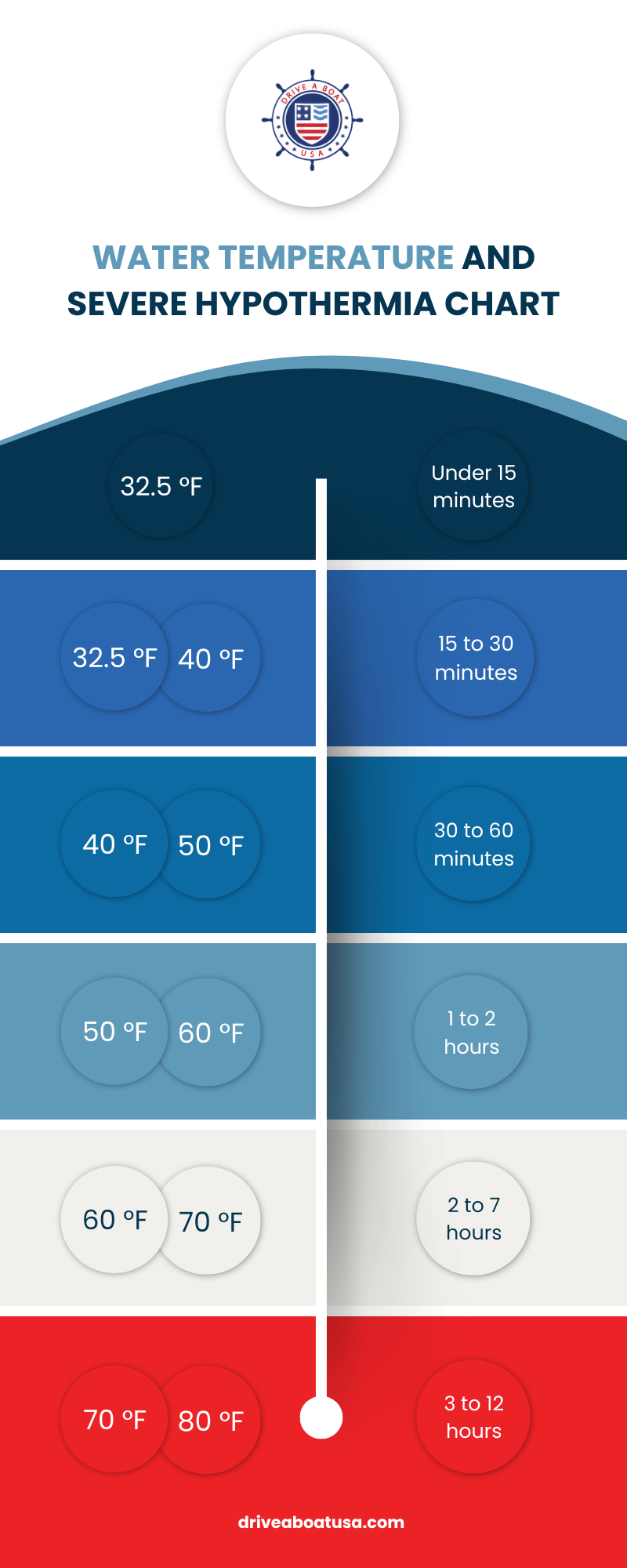Four Stages of Cold Water Immersion and Hypothermia Chart
Cold water immersion is a real risk when boating on both inland and coastal waters of the US.
While repeated immersion and exceptional physical fitness is proven to make you less susceptible to the effects of cold water immersion, even fit individuals and strong swimmers are at risk of drowning and in many cases, hypothermia.
Be prepared and know what to do if you or a fellow crew member falls off of your boat and is suddenly immersed in cold water.
What happens when you fall in cold water?
The instant you are immersed in cold water, your body will react involuntarily. You will gasp and hyperventilate, without being able to control these responses. Even if you are prepared and react appropriately, the risk of death continues to grow until you are rescued, and even after.
The danger is the same for experienced and inexperienced swimmers, surfers and boaters alike, and even happens in the so-called ‘warm’ waters of the Bahamas and Florida. Remember, your body temperature is still significantly higher than milder water bodies. Water as mild as 55 degrees can be deadly.
Falling in cold water on a warm day
Water temperatures in oceans, lakes and rivers remain very cold even in warm weather, so no matter how nice the weather is, and no matter where you are boating, knowing the risks and how to respond in an emergency could save your life.
Never underestimate the importance of choosing carefully whether to take to the water, and under what conditions. Small craft advisories are serious, as are all signs and warnings related to water safety.
Note that the USCG has taken a variety of initiatives to address the higher instances of boating deaths due to cold water immersion on warm days, with state-specific programs like THINK60 in Virginia to identify high risk days. These are days when air temperatures are above 60. Water temperature remains below 60. Cold water is just as dangerous on warm days.
Four stages of cold water immersion
Forget what you have seen in the movies. When Sandra Bullock’s non-swimming character fell into the water without a life jacket just off the coast of Alaska in The Proposal, she would have experienced a serious involuntary reaction, and would likely have drowned. More dramatic scenes in Mission Impossible and James Bond movies are equally unrealistic. So, what actually happens when you fall into cold water?
There are four stages of cold water immersion. They can lead to death by drowning or hypothermia, but being prepared and knowing what to do can increase your chances of survival.
Stage One: Cold Water Shock
When you are suddenly immersed in cold water, you will experience what is known as “cold shock.” Symptoms include significant changes in breathing, heart rate, and blood pressure. You will gasp and breathe rapidly.
This reaction puts you at risk of inhaling water and drowning almost instantly. You can cover your face with your hands if you realize you are about to fall into the water, to help minimize the amount of water you could inhale.
In the rough waters of coastal areas, rapid rivers and large lakes, the danger of drowning following cold shock is even greater.
Accidental immersion in cold water poses a life-threatening situation if you have no protection from the cold and/or are not wearing a life jacket.
Stage Two: Loss of coordination and swimming failure
After the initial shock of falling into cold water, your body does not simply recover. The cold rapidly leads to:
- Loss of movement in the hands
- Loss of coordination in the muscles in your arms and legs
Note that moving your arms and legs will not help reduce loss of coordination, and can even lead to even more rapid loss of body heat.
When you lose coordination, you lose your ability to swim. You may find yourself swimming at an increased angle, which demands more energy to keep your head above water. In many cases, swimming is not even advised, as it leads to faster heat loss (see below).
At this stage, wearing an approved life jacket design that will keep your head above water for you can save your life. Children are at even greater risk than adults of drowning following sudden immersion in cold water, and should always wear a life jacket of this type.
Stage Three: Hypothermia leading to loss of consciousness
Hypothermia is a medical emergency that occurs when the body loses heat faster than it can produce heat, leading to a dangerously low body temperature. Normal body temperature is around 98.6 F (37 C), and hypothermia occurs when the body temperature falls below 95 F (35 C).
Falling into cold water puts you at a very high risk of developing hypothermia, in this case called immersion hypothermia. In fact, your body can cool down up to 25 times faster in cold water than when surrounded by air of the same temperature.
Certain medical conditions or medications can increase the risk of hypothermia. Other risk factors include exhaustion, older age and very young age (children lose heat faster).
Stages of hypothermia
There are three stages of hypothermia.
- Mild hypothermia is characterized by shivering and slurred speech.
- Moderate hypothermia is identifiable by:
-
- Clumsiness and loss of muscle control
- Drowsiness
- Confusion/incoherence
- Exhaustion
- Severe hypothermia is characterised by:
-
- Collapse
- Loss of consciousness
- Slow breathing
- Weak pulse
- Respiratory distress and/or cardiac arrest, likely leading to death.
Hypothermia can lead to death in as little as 15 minutes.
How to maintain body heat in cold water
Preventing or delaying hypothermia is vital. To retain as much body heat as possible following cold water immersion, you can:
- Keep your clothes on while in the water to retain body heat.
- Limit body movement to reduce heat loss. Moving your arms and legs will not warm you up, it will cool you down. Only swim if you can reach a nearby object. Even strong swimmers can drown by swimming in cold water.
- Try to keep as much of your body, especially your head, out of the water as possible. Pull yourself onto a floating object or overturned boat if possible.
- Always wear a high quality PFD. USCG-approved life jackets will offer some insulation. The more of your body the PFD covers, the more protection it will offer.
- Wear a PFD that is the right size. Correctly sized life jackets keep you afloat with minimal effort on your part. The less you move, the more body heat you can retain.
- If you are alone in the water: hold your body in the Heat Escape Lessening Position (H.E.L.P.), also known as the fetal position. Pull your knees up and protect your armpits, sides of the chest, groin, and back of the knees, as these areas lose heat more quickly than other parts of the body.
- If you are in the water with others: huddle together facing each other with your arms around the others’ shoulders to share body heat.
Stage Four: Post-rescue collapse and potential dangers after being rescued
After being rescued from cold water, there is still a high risk that a person could pass on. Potential complications include:
Circum-Rescue Collapse: This phenomenon is not well understood but appears to be related to a sudden drop in blood pressure, potentially causing unconsciousness and heart issues. It can take place just before rescue, during rescue, or immediately afterwards.
Hypothermia Afterdrop: Unconscious, nonshivering hypothermia victims who are rescued and insulated from the cold may experience a further drop in body temperature, known as afterdrop, which can be as significant as 3 to 4 degrees Celsius
It is always recommended that you contact professional rescue personnel as soon as possible following involuntary immersion in cold water, via marine radio or any other type of approved marine communication device. In many cases, persons who have been immersed also suffer from injuries and trauma requiring professional medical care.
How to treat hypothermia
Follow these steps to help someone with immersion hypothermia while you wait for rescue personnel to arrive:
- Move the victim to a warm place.
- Check breathing and heartbeat, and perform CPR if necessary.
- Remove wet clothes and cover the victim with dry clothes or blankets. Be sure to cover their head. Do not apply heat directly to the arms and legs as it can lower core body temperature.
- If the person is awake and coherent, give them warm (not hot) liquids. Avoid giving alcohol as it can increase heat loss. Do not attempt to give food or drink to unconscious victims.
- After rescue, handle the victim carefully as blood pressure may drop, inhaled water can damage the lungs, and heart problems can develop due to cold blood from extremities being released into the body core. Do not massage the victim or give them a hot bath as it can lead to cardiac arrest.
Be prepared to boat safely with a state-approved boating license from Drive A Boat USA
There is always an element of the unknown when it comes to boating, but you can reduce the risk of injury or death by following safety regulations and proving you are prepared with a state-approved boating licence.
Did you know that following the rules for boat capacity limits can lower the risk of anyone on board falling into cold water? Did you know that filing a float plan can increase your chances of being rescued? Follow our online course to learn everything you need to know about safe boating.
Boaters in New York, Florida and California can earn their licence online from Drive A Boat USA!


